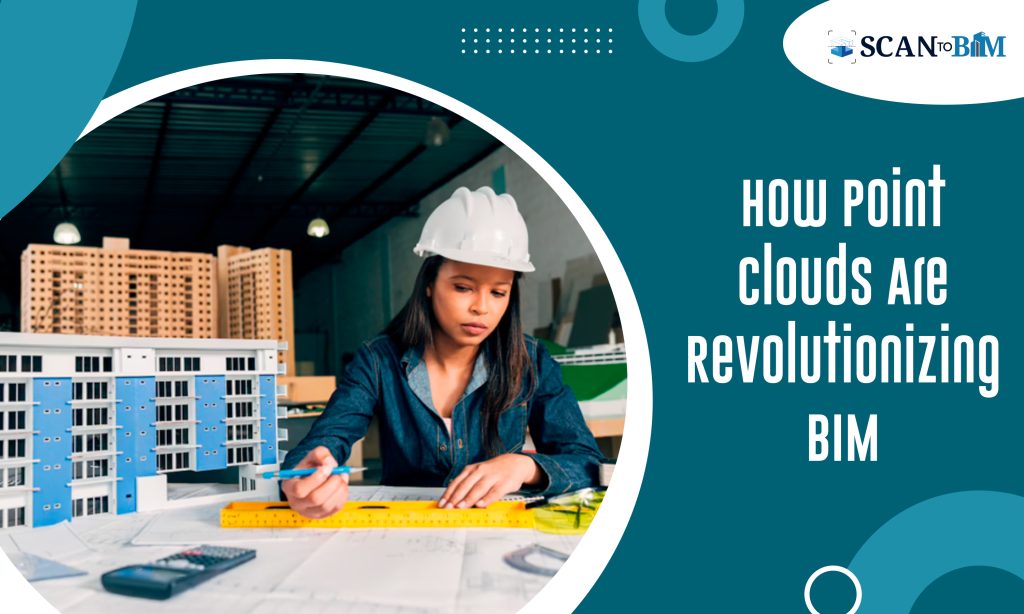
Introduction
By fostering cooperation, efficiency, and accuracy across the project lifecycle, building information modelling (BIM) has already revolutionized the architectural, engineering, and construction sectors. But the introduction of point clouds has elevated BIM to new levels, providing prospects for improved accuracy and faster processes. In this article, we’ll look at how point clouds are revolutionizing BIM and how services like Scan to BIM and Point Cloud to BIM Modelling are transforming the AEC environment.
Understanding Point Clouds and their significance in BIM
Large groups of data points known as point clouds are produced by 3D laser scanning or photogrammetry techniques. Together, these data points accurately and thoroughly depict the surface of an item or environment. Using point clouds as the base for a full digital picture of a structure, piece of infrastructure, or location, architects, engineers, and construction specialists are able to see the current state of a project with unrivalled accuracy. According to a McKinsey & Company report, the use of BIM reduces construction costs and time by 7-8% and 10-15%, respectively.
Stakeholders may acquire a thorough grasp of the project site’s real dimensions, terrain, and existing structures through the integration of point clouds into BIM processes. Teams are better able to make decisions in this data-rich environment, which leads to more effective planning, fewer conflicts, and cost savings. Point clouds are increasingly being used in BIM. Recent research by the National Institute of Building Sciences predicts that over the next five years, the incorporation of point clouds in BIM will increase by 20% annually.
The Rise of Point Cloud to BIM Modeling Services
The need for Point Cloud to BIM Modelling Services has increased along with the proliferation of 3D laser scanning technologies. These specialized services transform unprocessed point cloud data into insightful BIM models, greatly speeding up the design and construction process. The global market for 3D laser scanning is anticipated to surpass $4.08 billion by 2023, with a CAGR of 8.2% from 2018 to 2023, in accordance with a MarketsandMarkets analysis.
Advantages of Point Cloud to BIM Modeling Services
- Increased Accuracy: Point clouds gather real-world data with incredible precision, producing BIM models that accurately reflect the state of the world today. As a result, there are fewer mistakes and reworks throughout the design and construction phases.
- Time and Cost Efficiency: The modelling process is sped up by utilizing point cloud data, which also cuts down on human measurements and surveying time. As a result, project durations are accelerated and expenses are reduced.
- Clash Detection and Coordination: Collision detection and coordination are made possible by Point Cloud to BIM models, which minimize on-site disputes and adjustments by allowing collision detection with the as-built environment. With this proactive strategy, construction delays are avoided, and project results are enhanced.
- Retrofit and renovation initiatives: These things frequently lack thorough documentation, which brings us to point d. The redesign process is made simpler by the effective approach that Point Cloud to BIM Modelling Services effectively captures existing circumstances.
Scan to BIM Services: Transforming the Construction Landscape
Scan to BIM services use laser scans or point clouds to create useful BIM models, bridging the gap between the physical and digital worlds. BIM and 3D scanning technologies have combined to provide ground-breaking improvements in the construction sector.
Key Benefits of Scan to BIM Services
- Reliable As-Built Documentation: Scan to BIM Services offer precise as-built documentation, guaranteeing that the design and construction teams are fully aware of the building as it is.
- Increased cooperation: By centralizing data using BIM models, all project stakeholders may have access to up-to-date information, which promotes cooperation and lessens misunderstandings.
- Clash Mitigation: Scan to BIM services make it easier to spot conflicts between proposed designs and existing structures. This proactive strategy reduces rework and avoids building faults.
- Data-Driven Decision Making: Point cloud-derived, data-rich BIM models allow for data-driven decision-making, which results in more informed decisions and improved finished projects.
Here are a few instances of point clouds being applied to BIM
- Preconstruction: As-built representations of existing structures can be created using point clouds. Planning renovations or brand-new building projects might benefit from this.
- Construction: The progress of construction projects may be monitored using point clouds. This can make it easier to see possible issues early on and guarantee that the project is finished on schedule and under budget.
- Maintenance: Point clouds may be utilized to document building upkeep. This can assist in locating building components that require maintenance or replacement.
Conclusion
Point clouds are now a crucial component of BIM, allowing experts in the fields of architecture, engineering, and construction to visualize, evaluate, and optimize projects like never before. By increasing accuracy, lowering costs, and fostering better cooperation, Point Cloud to BIM Modelling Services and Scan to BIM Services have completely changed the building industry. The seamless integration of point clouds and BIM offers even greater efficiency and breakthroughs in the AEC industry, resulting in more sustainable, inventive, and successful projects as technology continues to progress.